



SAM’s historical American art collection comprises over 2,500 examples of painting, sculpture, works on paper, and decorative arts, featuring many works by nationally renowned and historically significant artists. In the past, the galleries presented a historical overview of American art history that did not fully consider the many histories and perspectives that have driven cultural production in North America from the 17th century to World War II, particularly those of artists active in the Pacific Northwest region’s diverse communities. American Art: The Stories We Carry takes a dramatically different approach, bringing the historical American art collection into conversation with Native, Asian American, African American, Latinx, and contemporary art, including several important new acquisitions and commissions. This new interpretive framework brings forward historically excluded narratives and artistic forms, opening up new opportunities for curiosity, critique, and connection for all visitors.
American Art: The Stories We Carry presents five thematic galleries in which many ideas overlap. Storied Places explores how people interact with land and places. Transnational America unearths the histories embedded in objects of migration, trade, and exploration. Reimagining Regionalism, curated by Inye Wokoma, elevates historically excluded narratives of communities in the Pacific Northwest. Ancestors and Descendants features the multiplicity of American identities. Memory Keepers, on view October 2022–April 2023, reflected on the Pacific Northwest region’s different cultural practices of storytelling and remembering. In April 2023, the gallery was reinstalled as Reaching Back, Guiding the Future, probing the country’s legacy of structural racism to advance a more equitable future. Below, explore new conversations between selected works in each thematic gallery.
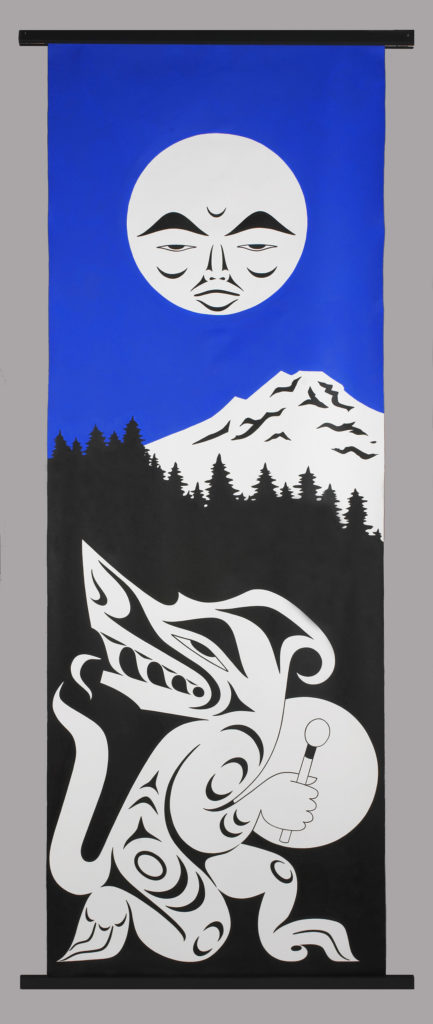
Song for the Moon, 2002, Shaun Peterson (Qwalsius)
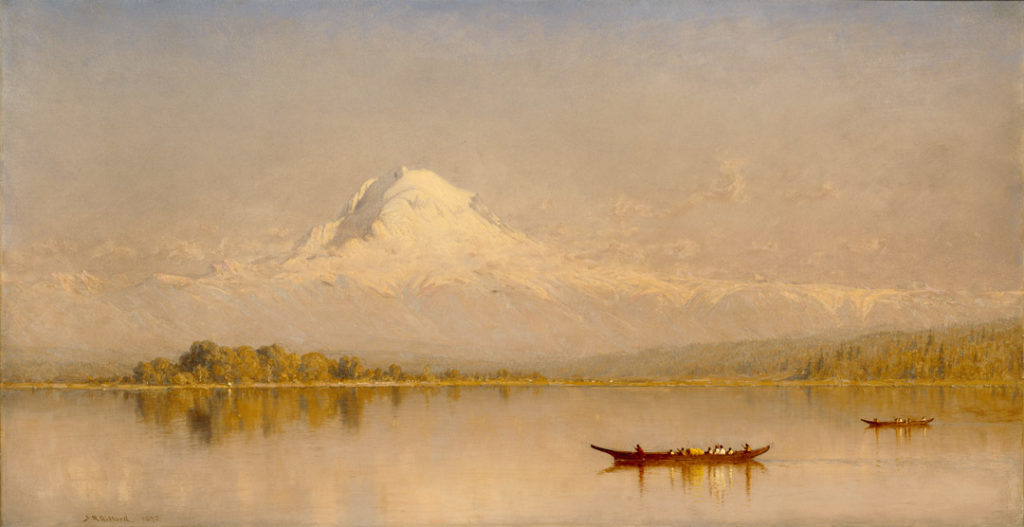
Mount Rainier, Bay of Tacoma – Puget Sound, 1875, Sanford Robinson Gifford
The first gallery that visitors enter in the installation, Storied Places fittingly starts with the land itself, exploring diverse approaches to place, nature, and the landscape genre. Shaun Peterson (Tulalip/Puyallup) is a contemporary artist who both carves cedar and paints on canvas. With the graphic, banner-like Song for the Moon (2022), he echoes a spiritual connection to the land, bringing a narrative long transmitted orally into vivid representation: the story of dukwibuł, the Changer who formed the land, and Wolf, who protects humans through prayer and ceremony. Nearby, Sanford Robinson Gifford’s Mount Rainier, Bay of Tacoma – Puget Sound (1875) reflects a tradition of capturing sublime places that are meant to be observed or tamed. Gifford’s focus is the immense beauty of the light and the mountain (called Tahoma by the region’s original inhabitants). He did not intend the figures rowing across the water to be specific portraits, while visitors today may wonder about them: are they perhaps traveling by canoe to work in the hop fields?

Gypsy Baron crazy quilt, ca. 1887, Mrs. Jones
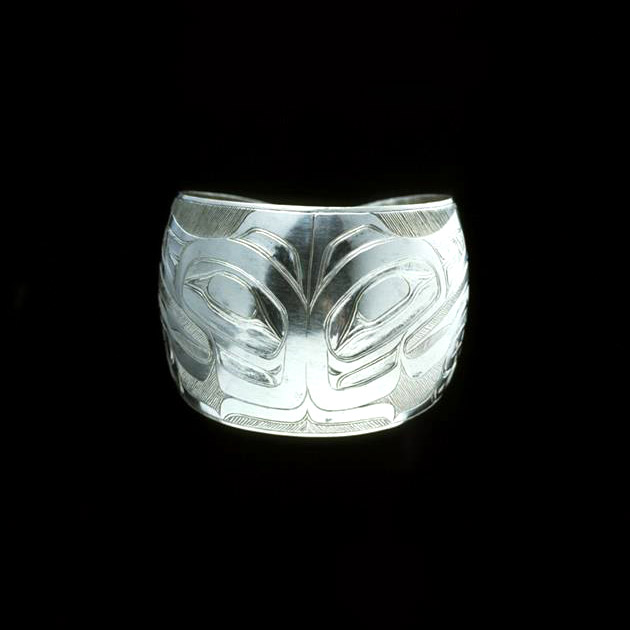
Bracelet, totemic eagle design, ca. 1900,
Native American, Haida
.
Transnational America explores how North America became part of a global network of ideas, economies, and cultures that flows in and out of its borders. A Haida bracelet with a totemic eagle design (ca. 1900) was created for trade by an unknown maker from silver coin of Russian or American origin. Native artists responded to new markets brought about by colonialism by creating objects in silver, wood, and argillite; however, these artworks were dismissed by their buyers as craft and not valued as works of technical genius and deep cultural expression. Similarly, Gypsy Baron crazy quilt (ca. 1887) by an artist known only as Mrs. Jones, is layered with both material and meaning. Though used in a typical domestic setting, the kaleidoscopic arrangement of imported materials and Asian motifs brought together by an English stitching technique evoke the complex system of international trade and cultural exchange that made it possible.
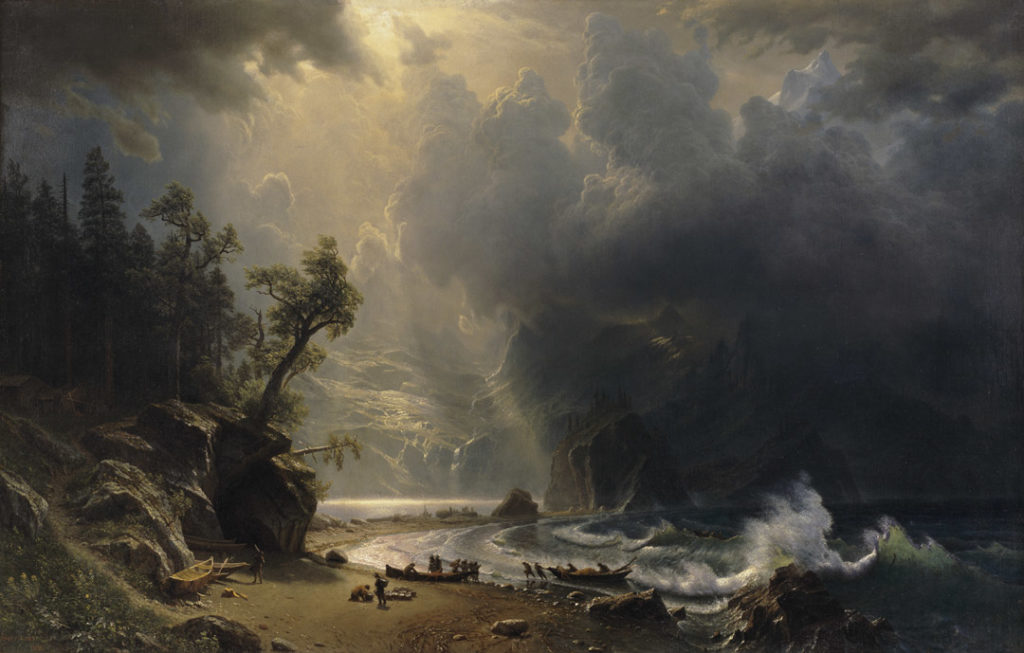
Puget Sound on the Pacific Coast, 1870, Albert Bierstadt

Elevator screen from the Chicago Stock Exchange, ca. 1893–94, Louis Sullivan
Reimaging Regionalism was curated by Inye Wokoma, a visual artist and co-founder of Black cultural space Wa Na Wari. Invited by the museum to create a new artwork, he was inspired to curate a new interpretive framework around some of the collection’s most well-known works. Albert Bierstadt created the epic painting Puget Sound on the Pacific Coast (1870) without ever visiting the area; its billowing clouds and charging waves are an act of imagination. The Indigenous figures along the dramatic shoreline seem inconsequential to the grand possibilities of the land: the subtext for this painting commissioned by a wealthy merchant. The elevator screen from the Chicago Stock Exchange (ca. 1893-94) by the “father of skyscrapers” Louis Sullivan is an utterly literal symbol of economic expansion, its seed grain symbols representing the overwhelming might of colonialism. Now installed so that visitors can move entirely around it and look through it, the screen offers an opportunity to consider what this gateway was leading to—and what it kept out.
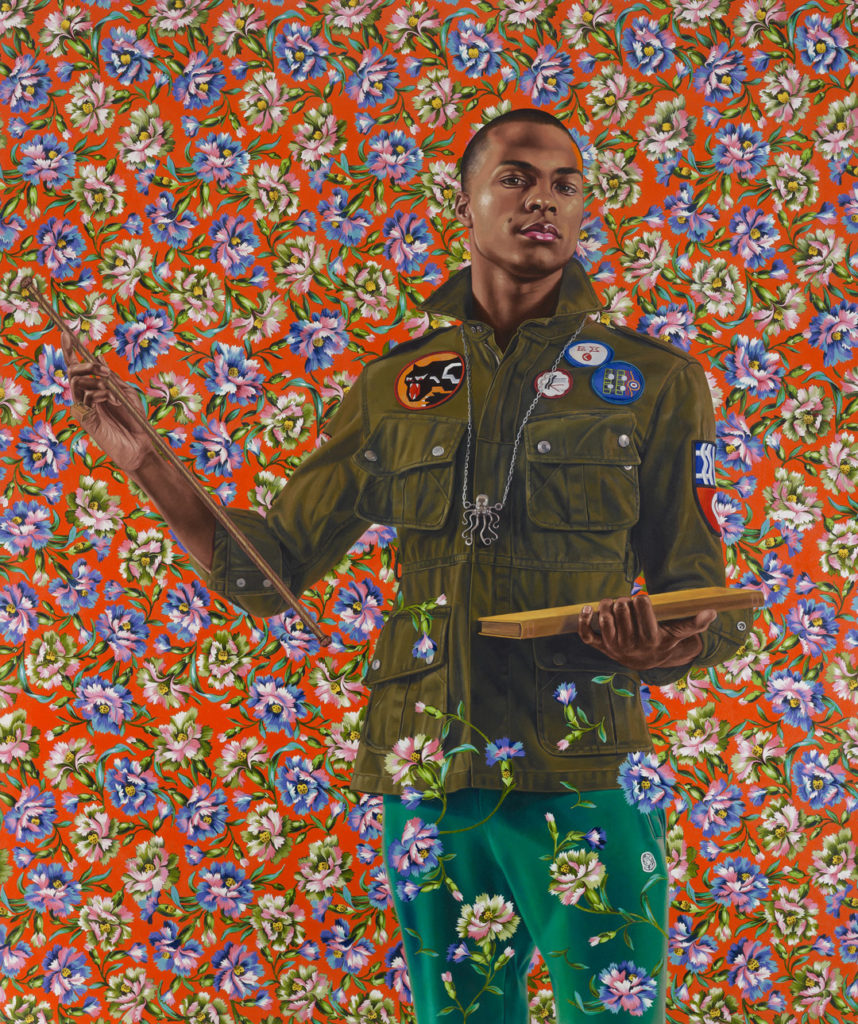
Anthony of Padua, 2013, Kehinde Wiley
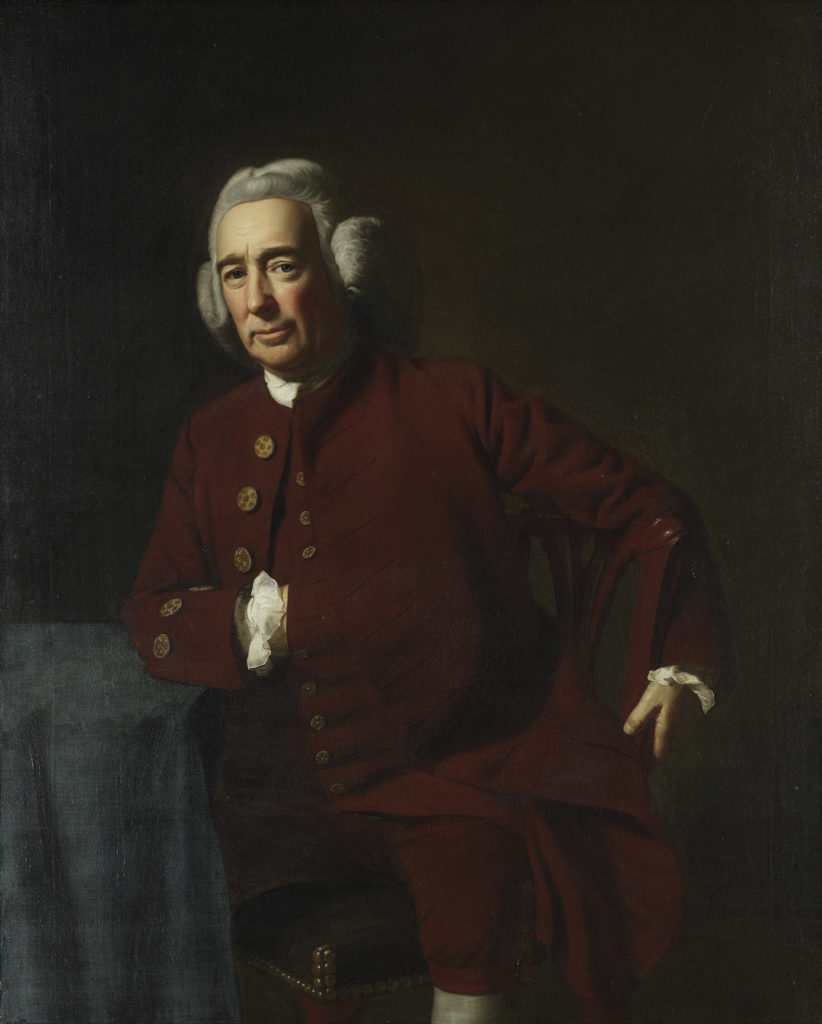
Dr. Silvester Gardiner (1708-1786), probably 1772, John Singleton Copley
In Ancestors and Descendants, a more recent acquisition to the contemporary collection—Anthony of Padua (2013) by Kehinde Wiley—boldly takes its place in a gallery that also includes a well-known 1772 work by John Singleton Copley. Copley’s Dr. Silvester Gardiner (1708-1786) captures the prominent Boston physician and landowner in a powdered wig and expensive suit of clothes, conveying his wealth and authority. Wiley plays with these aesthetic conventions of the portraiture genre: rather than depicting aristocrats or elites, he invites people he meets on the street to pose in their own style. Placed side-by-side, the striking similarities of the figures’ poses highlight their differences, creating a dramatic reimagining of a historical paradigm.
Visitor advisory: loud and sustained screams may echo from this gallery into other areas of the museum.

Neon American Anthem, 2023, Nicholas Galanin

White Flag, 2001, Jack Daws
In Reaching Back, Guiding the Future, three artworks come together in a dramatic challenge to the legacy of structural racism and colonialism in the US. Nicholas Galanin’s commission for SAM, Neon American Anthem (2023), fills the gallery with white light from a custom neon installation that offers a proclamation and an invitation: “I’ve composed a new American national anthem: take a knee and scream until you can’t breathe.” Galanin envisions the work as a participatory performance piece that engages museum visitors to ring out with sounds of protest, mourning, or celebration. On the floor lies a grid of “Daisy Doormats,” the iconic AstroTurf welcome mats with plastic daisies in the corners; this symbol of Americana becomes both unsettling and humorously ironic in this setting. Another artist who makes scorching use of the color white and national symbols is Jack Daws; two of his works from SAM’s collection join Galanin’s. His White Flag (2001) is an all-white American flag that glimmers audaciously: is it signaling a surrender or exposing the country’s entrenched power structure?
Please Note: Neon American Anthem is open 1–5 pm Wednesday–Friday, and all day Saturday and Sunday.
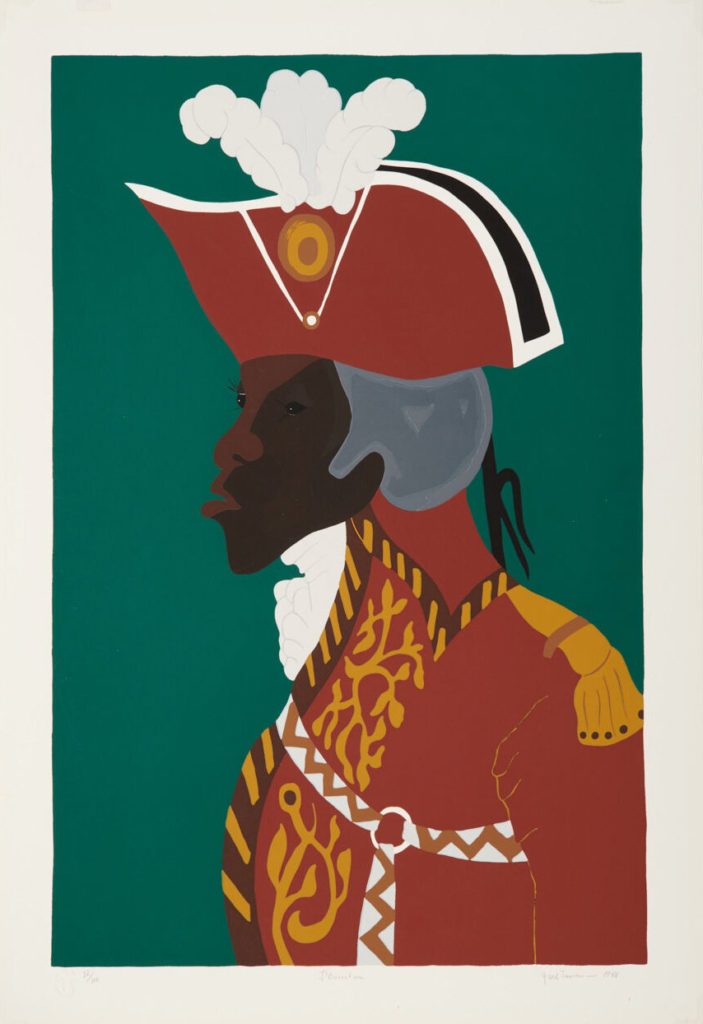
General Toussaint L’Ouverture, 1986, Jacob Lawrence
The reinstallation also debuts a new direction for one of the museum’s galleries dedicated to modern American art: the gallery will feature ongoing temporary installations exploring fresh perspectives in American art.
The first iteration presents the narrative series The Life of Toussaint L’Ouverture (1986–97) by Jacob Lawrence (1917–2000). The 15 silkscreen prints are a recent acquisition by the museum and are on view at SAM for the first time. The series—originally painted by Lawrence in 1936—celebrates the revolutionary Haitian strategist and statesman (1743-1803) who liberated his country from colonial rule to establish the first independent Black republic. Lawrence’s signature compressed spaces and cubist forms capture key moments from Toussaint’s biography—his childhood in slavery, his fortitude as a leader, his victory and betrayal, and his enduring legacy—to serve as an anthology of revolutionary valor that would resonate with contemporary struggles.
American Art: The Stories We Carry presents two exciting new commissions by Wendy Red Star (Apsáalooke) and Nicholas Galanin (Tlingit/Unangax̂).
When visitors approach the reinstalled American art galleries, they are beckoned by the light of Red Star’s lightbox installation, Áakiiwilaxpaake (People Of The Earth), a compelling hybrid of American art genres: the portrait and the landscape. Red Star invited Seattle photographer Holli Margell to create portraits of local Native women and children and set them within the iconic Seattle skyline, including Mount Rainier (also known as Tahoma). By recalling the history of the region’s original inhabitants, Red Star celebrates the vibrant present and future of Natives in their home territories as well as urban Natives.
The question of what is illuminated and what isn’t also defines Galanin’s Neon American Anthem, which debuted in April 2023. The scorching installation of custom neon text proclaims—and invites the viewer to participate in—a “new American anthem,” recalling recent events of institutional violence but also reaching back into the long history of American oppression with the ultimate goal of opening up the viewer to new possibilities for change.

Áakiiwilaxpaake (People Of The Earth), 2022, Wendy Red Star

Neon American Anthem, 2023, Nicholas Galanin
Joseph Anthony Jr., Alfredo Arreguín, Coast Salish Artist, Sierra Leone Artist, Tsimshian Artist, Haida Artist(s), Kwakwa̱ka̱ʼwakw Artist(s), Makah Artist(s), Nuu-chah-nulth, Hesquiat Artist(s), Tlingit Artist(s), Albert Bierstadt, Grafton Tyler Brown, George de Forest Brush, Kenneth Callahan, Frederic Edwin Church, John Singleton Copley, William Cumming, Jack Daws, Jeremiah Dummer, Thomas Eakins, Charles Edenshaw, Henry Farny, Earl Fields, Nicholas Galanin, Robert Swain Gifford, Sanford Robinson Gifford, Morris Graves, Marsden Hartley, Childe Hassam, Z. Vanessa Helder, Robert Henri, Mrs. Jones, John Frederick Kensett, Jacob Lawrence, Emanuel Leutze, Joseph Loring, Joseph Lownes, Alfredo Ramos Martinez, John McMullin, Willard Metcalf, Blanche Morgan, Kenjiro Nomura, William McGregor Paxton, Raphaelle Peale, Shaun Peterson (Qwalsius), Alexander Phimister Proctor, Wendy Red Star, Diego Rivera, Cleveland Rockwell, John Singer Sargent, Augusta Savage, Amy Sherald, Roger Y. Shimomura, Francis A. Silva, Louis Sullivan, Philip Syng Jr., Tiffany & Co., Mark Tobey, Kamekichi Tokita, George Tsutakawa, Julius Twohy, Marie Watt, Kehinde Wiley, Will Willson, Inye Wokoma, Newell Convers Wyeth, Rudolph Franz Zallinger
Discover more about the artworks on view in SAM’s American art galleries with stories, videos, and other exclusive content on SAM’s YouTube channel and SAM Blog.
Perspectives on American Art: Inye Wokoma on Beauty, Critique, and Personal Revelations
Object of the Week: Coulee Dam Construction
Object of the Week: Salt Cellar
The History in Art History, Part I: How This Painting Came to Seattle
The History in Art History, Part II: How This Painting Came to Seattle
Object of the Week: The Studio
Object of the Week: Mount Rainier, Bay of Tacoma—Puget Sound
Get to Know SAM’s New American Art Curator, Theresa!
Object of the Week: Gwendolyn Knight
Object of the Week: Blanket Stories
Object of the Week: Elevator Screen From the Chicago Stock Exchange
Kehinde Wiley’s Galvanizing Impact
SAM Creates: Powerful Portraits the Wiley Way
Object of the Week: Anthony of Padua
Object of the Week: Still Life with Strawberries and Ostrich Egg Cup
Go Tell It: Civil Rights Photography at Seattle Art Museum
Object of the Week: A Woman with Red Hair
Wyeth’s Cast of Characters: N.C. Wyeth